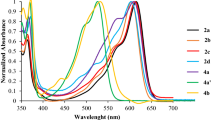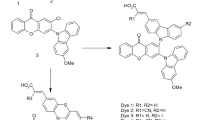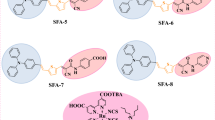Abstract
2-Chloro-(n-alkylamino)pyridine-1,4-naphthoquinones as photosensitizers, viz. 2-chloro-3[(pyridine-2-ylmethyl)amino]naphthalene-1,4-dione (2AMP), 2-chloro-3[(pyridine-3-ylmethyl)amino]naphthalene-1,4-dione (3AMP), and 2-chloro-3[(2-pyridine-2-ylethyl)amino)]aphthalene-1,4-dione (2AEP), are synthesized and studied for TiO2 and ZnO-based dye-sensitized solar cells (DSSCs). The FE-SEM, powder XRD, UV–Visible spectroscopy, FT-IR, and J–V characteristics were used to investigate the morphology, crystallinity, and optical and electrochemical properties of the photosensitizer-adsorbed TiO2 and ZnO photoelectrodes. Optical properties of photoelectrodes are noticed in the visible spectrum and are assigned to n→π* charge transfer transition. The PXRD pattern confirms the hexagonal Wurtzite crystal structure of ZnO and the anatase phase of TiO2 photoelectrodes. The TiO2/3AMP photoelectrode-based DSSCs exhibited higher efficiency (η) than other photoelectrodes (TiO2/2AMP, TiO2/2AEP, ZnO/2AMP, ZnO/3AMP, and ZnO/2AEP) because of its better photosensitizer adsorption and rapid electron injection. The photosensitizers are actively breaking down the energy barrier and reducing the electron recombination losses. The current work will provide a new method for fabricating the DSSCs that rely on D–π–A motif-based 2-Chloro-(n-alkylamino)pyridine-1,4-naphthoquinones photosensitizers and morphology-dependent photoelectrodes.








Similar content being viewed by others
Data availability
Data from the results of this study are provided in the article.
References
I. Dincer, C. Acar, A review on clean energy solutions for better sustainability. Int. J. Energy Res. 39, 585–606 (2015). https://doi.org/10.1002/er.3329
S. Mozaffari, M.R. Nateghi, M.B. Zarandi, An overview of the challenges in the commercialization of dye sensitized solar cells. Renew. Sustain. Energy Rev. 71, 675–686 (2017). https://doi.org/10.1016/j.rser.2016.12.096
P. Chelvanathan, S.A. Shahahmadi, F. Arith, K. Sobayel, M. Aktharuzzaman, K. Sopian, F.H. Alharbi, N. Tabet, N. Amin, Effects of RF magnetron sputtering deposition process parameters on the properties of molybdenum thin films. Thin Solid Films. 638, 213–219 (2017). https://doi.org/10.1016/j.tsf.2017.07.057
A. Nizamuddin, F. Arith, I.J. Rong, M. Zaimi, A.S. Rahimi, S. Saat, Investigation of copper(I)thiocyanate (CuSCN) as a hole transporting layer for perovskite solar cells application. J. Adv. Res. Fluid Mech. Therm. Sci. 78, 153–159 (2021). https://doi.org/10.37934/arfmts.78.2.153159
N.S. Noorasid, F. Arith, A.N. Mustafa, M.A. Aam, S. Mahalingam, P. Chelvanathan, N. Amin, Current advancement of flexible dye sensitized solar cell: a review. Optik Int. J. Light Electron Opt. 254, 168089 (2022). https://doi.org/10.1016/j.ijleo.2021.168089
N.S. Noorasid, F. Arith, A.N.M. Mustafa, S.H. M.Suhaimy, A.S. Mohd Shah, M.A. Azam, Numerical analysis of ultrathin TiO2 photoanode layer of dye sensitized solar cell by using SCAPS-1D, In: Proceedings of the IEEE Regional Symposium on Micro and Nanoelectronics 96–99 (2021) https://doi.org/10.1109/RSM52397.2021.9511600
O.V. Aliyaselvam, F. Arith, M.K. Nor, A.N.M. Mustafa, O. Ahmed, Solution processed of solid state HTL of CuSCN layer at low annealing temperature for emerging solar cell. Int. J. Renew. Energy Res. 11, 869–878 (2021). https://dorl.net/dor/20.1001.1.13090127.2021.11.2.35.4
K. Sharma, V. Sharma, S.S. Sharma, Dye-sensitized solar cells: fundamentals and current status. Nanoscale Res. Lett. 13, 381 (2018). https://doi.org/10.1186/s11671-018-2760-6
C. Cavallo, F. Di Pascasio, A. Latini, M. Bonomo, D. Dini, Nanostructured semiconductor materials for dye-sensitized solar cells. J. Nanomater. 2017, 5323164 (2017). https://doi.org/10.1155/2017/5323164
L. Zhang, X. Yang, W. Wang, G.G. Gurzadyan, J. Li, X. Li, J. An, Z. Yu, H. Wang, B. Cai, A. Hagfeldt, Sun,13.6% efficient organic dye-sensitized solar cells by minimizing energy losses of the excited state. ACS Energy Lett. 4, 943–951 (2019). https://doi.org/10.1021/acsenergylett.9b00141
H.J. Snaith, Estimating the maximum attainable efficiency in dye-sensitized solar cells. Adv. Funct. Mater. 20, 13–19 (2010). https://doi.org/10.1002/adfm.200901476
B.C. O’Regan, J.R. Durrant, Kinetic and energetic paradigms for dye-sensitized solar cells: moving from the ideal to the real. Acc. Chem. Res. 42, 1799–1808 (2009). https://doi.org/10.1021/ar900145z
F. Fabregat-Santiago, G. Garcia-Belmonte, I. Mora-Sero, J. Bisquert, Characterization of nanostructured hybrid and organic solar cells by impedance spectroscopy. Phys. Chem. Chem. Phys. 13, 9083–9118 (2011). https://doi.org/10.1039/C0CP02249G
T. Stergiopoulos, P. Falaras, Minimizing energy losses in dye-sensitized solar cells using coordination compounds as alternative Redox Mediators coupled with Appropriate Organic Dyes. Adv. Energy Mater. 2, 616–627 (2012). https://doi.org/10.1002/aenm.201100781
J.N. Clifford, E. Martínez-Ferrero, E. Palomares, Dye mediated charge recombination dynamics in nanocrystalline TiO2 dye sensitized solar cells. J. Mater. Chem. 22, 12415–12422 (2012). https://doi.org/10.1039/C2JM16107A
M.J. Griffith, K. Sunahara, P. Wagner, K. Wagner, G.G. Wallace, D.L. Officer, A. Furube, R. Katoh, S. Mori, A.J. Mozer, Porphyrins for dye-sensitized solar cells: new insights into efficiency-determining electron transfer steps. Chem. Commun. 48, 4145–4162 (2012). https://doi.org/10.1039/C2CC30677H
A. Kunzmann, S.E. Valero, A. Sepúlveda, M. Rico-Santacruz, E.R. Lalinde, J. Berenguer, J.M. García-Martínez, D. Guldi, E.D. Serrano, R. Costa, Hybrid dye-titania nanoparticles for superior low-temperature dye-sensitized solar cells. Adv. Energy Mater. 8, 1702583 (2018). https://doi.org/10.1002/aenm.201702583
E.M. Elsayed, A.E. Shalan, M.M. Rashad, Preparation of ZnO nanoparticles using electrodeposition and co-precipitation techniques for dye-sensitized solar cells applications. J. Mater. Sci. Mater. Electron. 25, 3412–3419 (2014). https://doi.org/10.1007/s10854-014-2033-9
S. Haid, M. Marszalek, A. Mishra, M. Wielopolski, J. Teuscher, J.E. Moser, R. Humphry-Baker, S.M. Zakeeruddin, M. Grätzel, P. Bäuerle, Significant improvement of dye-sensitized solar cells performance by small structural modification in π-Conjugated donor-acceptor dyes. Adv. Funct. Mater. 22, 1291–1302 (2012). https://doi.org/10.1002/adfm.201102519
Y. Hong, J.-Y. Liao, D. Cao, X. Zang, D.-B. Kuang, L. Wang, H. Meier, C.-Y. Su, Organic dye bearing asymmetric double donor–π–acceptor chains for dye-sensitized solar cells. J. Org. Chem. 76, 8015–8021 (2011). https://doi.org/10.1021/jo201057b
Y. Gao, X. Li, Y. Hu, Y. Fan, J. Yuan, N. Robertson, J. Hua, S.R. Marder, Effect of an auxiliary acceptor on D–A–π–A sensitizers for highly efficient and stable dye-sensitized solar cells. J. Mater. Chem. A 4, 12865–12877 (2016). https://doi.org/10.1039/C6TA05588E
S.A. Mahadik, H.M. Pathan, S. Salunke-Gawali, R.J. Butcher, Aminonaphthoquinones as photosensitizers for mesoporous ZnO based dye-sensitized solar cells. J. Alloy Compd. 845, 156279 (2020). https://doi.org/10.1016/j.jallcom.2020.156279
L. López, E. Leyva, García de la Cruz, Las Naftoquinonas: Más Que Pigmentos Naturales. Rev. Mex Ciencias Farm. 42, 311–346 (2011)
L.I. López López, S.D. Nery Flores, S.Y. Silva Belmares, A. Sáenz Galindo, Naphthoquinones: biological properties and synthesis of lawsone and derivatives—A structured review. Vitae 21, 248–258 (2014)
A.P. Ware, A. Patil, S. Khomane, T. Weyhermuller, S.S. Pingale, S. Salunke-Gawali, Naphthoquinone based chemosensor 2-(2’-aminomethylpyridine)-3-chloro-1,4-naphthoquinone for metal ions: single crystal x-ray-crystal structure, experimental and TD-DFT study. J. Mol. Struct 1093, 39–48 (2015). https://doi.org/10.1016/j.molstruc.2015.03.016
A. Patil, A.P. Ware, S. Bhand, D. Chakrovarty, R. Gonnade, S.S. Pingale, S. Salunke-Gawali, Naphthoquinone based chemosensor 2-(2’-aminoethylpyridine)-3-chloro-1,4-naphthoquinone: detection of metal ions, x-ray-crystal structures and DFT studies. J. Mol. Struct 1114, 132–143 (2016). https://doi.org/10.1016/j.molstruc.2016.02.065
S. Madhupriya, K.P. Elango, Spectrophotometric and spectrofluorimetric studies on the selective sensing of fluoride ions by Co(II) and ni(II) complexes of naphthoquinone derivative possessing enhanced H-bonding property. Spectrochim Acta, Part A 97, 429–434 (2012). https://doi.org/10.1016/j.saa.2012.06.020
S. Madhupriya, K.P. Elango, Highly selective colorimetric sensing of Cu(II) ions in aqueous solution via modulation of intramolecular charge transfer transition of aminonaphthoquinone chemosensor. Spectrochim Acta, Part A 97, 100–104 (2012). https://doi.org/10.1016/j.saa.2012.05.044
D.R. Burfield, R.H. Smithers, Desiccant efficiency in solvent and reagent drying. 7. Alcohols. J. Org. Chem. 48, 2420–2422 (1983). https://doi.org/10.1021/jo00162a026
D.D. Perrin, W. Armarego, D.R. Perrin, Purification of laboratory chemicals. Pergamon Press, London, p. 260 (1988)
S.S. Khadtare, A.P. Ware, S. Salunke-Gawali, S.R. Jadkar, S.S. Pingale, H.M. Pathan, Dye sensitized solar cell with lawsone dye using a ZnO photoanode: experimental and TD-DFT study. RSC Adv. 5, 17647–17652 (2015). https://doi.org/10.1039/C4RA14620D
S.S. Khadtare, S.R. Jadkar, S. Salunke-Gawali, H.M. Pathan, Lawsone sensitized ZnO photoelectrodes for dye sensitized solar cells. J. Nano Res. 24, 140–145 (2013). https://doi.org/10.4028/www.scientific.net/JNanoR.24.140
S.A. Mahadik, A. Patil, H.M. Pathan, S. Salunke-Gawali, R.J. Butcher, Thionaphthoquinones as photosensitizers for TiO2 nanorods and ZnO nanograin based dye-sensitized solar cells: effect of nanostructures on charge transport and photovoltaic performance. Eng. Sci. 14, 46–58 (2021). https://doi.org/10.30919/es8d1160
S.B. Jambure, G.S. Gund, D.P. Dubal, S.S. Shinde, C.D. Lokhande, Cost effective facile synthesis of TiO2 nanograins for flexible DSSC application using Rose Bengal Dye. Electron. Mater. Lett. 10, 943–950 (2014). https://doi.org/10.1007/s13391-014-3200-0
S.S. Sahoo, S. Salunke-Gawali, V.S. Kadam, H.M. Pathan, Canna lily red and yellow flower extracts: a new power source to produce photovoltage through dye-sensitized solar cells. Energy Fuels 34, 9674–9682 (2020). https://doi.org/10.1021/acs.energyfuels.0c01482
N.I. Beedri, V.B. Mokashi, S.A. Mahadik, H.M. Pathan, S. Salunke-Gawali, Naphthoquinoneoxime-sensitized titanium dioxide photoanodes: photoelectrochemical properties. ACS Omega 7, 41519–41530 (2022). https://doi.org/10.1021/acsomega.2c05334
S.B. Vinayak, V. Balasubramani, M. Shkir, M.A. Manthrammel, G. Sreedevi, Enhancing the performance of TiO2 based NDSSC using dye extracted from Cladophora Columbiana, Ludwigiarepens and mixed sensitizer. Opt. Mater. 133, 112968 (2022). https://doi.org/10.1016/j.optmat.2022.112968
B.-Q. Liu, X.-P. Zhao, W. Luo, The synergistic effect of two photosynthetic pigments in dye-sensitized mesoporous TiO2 solar cells. Dyes Pigm. 76, 327–331 (2008). https://doi.org/10.1016/j.dyepig.2006.09.004
A.A. Adeniyi, T.L. Ngake, J. Conradie, Cyclic voltammetric study of 2-Hydroxybenzophenone (HBP) derivatives and the corrspondent change in the orbital energy levels in different solvents. Electroanalysis 32, 2659–2668 (2020). https://doi.org/10.1002/elan.202060163
K. Tennakone, G.K.R. Senadeera, D.B.R.A. De Silva, I.R.M. Kottegoda, Highly stable dye-sensitized solid-state solar cell with the semiconductor 4CuBr 3S(C4H9)2 as the hole collector. Appl. Phys. Lett. 77, 2367 (2000). https://doi.org/10.1063/1.1312858
V. Rondán-Gómez, I.M. De Los Santos, D. Seuret-Jiménez, F. Ayala-Mató, A. Zamudio-Lara, T. Robles-Bonilla, M. Courel, Recent advances in dye-sensitized solar cells. Appl. Phys. A 125, 836 (2019). https://doi.org/10.1007/s00339-019-3116-5
M. Urbani, M. Grätzel, M.K. Nazeeruddin, T. Torres, Meso-Substituted porphyrins for dye-sensitized solar cells. Chem. Rev. 114, 12330–12396 (2014). https://doi.org/10.1021/cr5001964
S. Qu, C. Qin, A. Islam, Y. Wu, W. Zhu, J. Hua, H. Tian, L. Han, A novel D–A-π-A organic sensitizer containing a diketopyrrolopyrrole unit with a branched alkyl chain for highly efficient and stable dye-sensitized solar cells. Chem. Commun. 48, 6972–6974 (2012). https://doi.org/10.1039/C2CC31998E
S.M. Feldt, E.A. Gibson, E. Gabrielsson, L. Sun, G. Boschloo, A. Hagfeldt, Design of organic dyes and cobalt polypyridine redox mediators for high-efficiency dye-sensitized solar cells. J. Am. Chem. Soc. 132, 16714–16724 (2010). https://doi.org/10.1021/ja1088869
M. Liang, J. Chen, Arylamine organic dyes for dye-sensitized solar cells. Chem. Soc. Rev. 42, 3453–3488 (2013). https://doi.org/10.1039/C3CS35372A
L.L. Li, E.W.G. Diau, Porphyrin-sensitized solar cells. Chem. Soc. Rev. 42, 291–304 (2013). https://doi.org/10.1039/C2CS35257E
N.I. Beedri, P.K. Baviskar, M.A. Mahadik, S.R. Jadkar, J.S. Jang, H.M. Pathan, Efficiency enhancement for cocktail dye sensitized Nb2O5 photoanode towards dye sensitized solar cell. Eng. Sci. 8, 76–82 (2019). https://doi.org/10.1021/jp203296y
S. Majumder, P.K. Baviskar, B.R. Sankapal, Light-induced electrochemical performance of 3D-CdS nanonetwork: effect of annealing. Electrochim. Acta 222, 100–107 (2016). https://doi.org/10.1016/j.electacta.2016.10.147
J. Yoon, M. Jin, M. Lee, Laser-induced control of TiO2 porosity for enhanced photovoltaic behavior. Adv. Mater. 23, 3974–3978 (2011). https://doi.org/10.1002/adma.201101837
Y. Li, Q. Tang, L. Yu, X. Yan, L. Dong, Cost-effective platinum alloy counter electrodes for liquid-junction dye-sensitized solar cells. J. Power Sources. 305, 217–224 (2016). https://doi.org/10.1016/j.jpowsour.2015.11.063
K.D. Seo, B.S. You, I.T. Choi, M.J. Ju, M. You, H.S. Kang, H.K. Kim, Dual-channel anchorable organic dyes with well-defined structures for highly efficient dye-sensitized solar cells. J. Mater. Chem. A 1, 9947–9953 (2013). https://doi.org/10.1039/C3TA11832K
M.J. Jeng, Y.L. Wung, L.B. Chang, L. Chow, Particle size effects of TiO2 Layers on the solar efficiency of dye-sensitized solar cells. Int. J. Photoenergy 2013, 563897 (2013). https://doi.org/10.1155/2013/563897
M. Adachi, M. Sakamoto, J. Jiu, Y. Ogata, S. Isoda, Determination of parameters of electron transport in dye-sensitized solar cells using electrochemical impedance spectroscopy. J. Phys. Chem. B 110, 13872–13880 (2006). https://doi.org/10.1021/jp061693u
W.C. Chang, C.H. Lee, W.C. Yu, C. Lin, Optimization of dye adsorption time and film thickness for efficient ZnO dye-sensitized solar cells with high at-rest stability. Nanoscale Res. Lett. 7, 688 (2012). https://doi.org/10.1186/1556-276X-7-688
H.K. Dunn, P.O. Westin, D.R. Sta, L.M. Peter, A.B. Walker, G. Boschloo, A. Hagfeldt, Determination of the electron diffusion length in dye-sensitized solar cells by substrate contact patterning. J. Phys. Chem. C 115, 13932–13937 (2011). https://doi.org/10.1021/jp203296y
Acknowledgements
SAM is thankful to Chhatrapati Shahu Maharaj Research, Training and Human Development Institute Pune, India, for financial support vide Chhatrapati Shahu Maharaj Research Fellowship-2020 (CSMNRF-2020).
Author information
Authors and Affiliations
Contributions
SAM participated in the conceptualization, methodology, data curation, and writing of the original draft. SSG participated in the conceptualization, writing, reviewing, and editing of the manuscript, data curation, and supervision.
Corresponding author
Ethics declarations
Conflict of interest
The authors declare no conflict of interest.
Additional information
Publisher’s Note
Springer Nature remains neutral with regard to jurisdictional claims in published maps and institutional affiliations.
Supplementary Information
Below is the link to the electronic supplementary material.
Rights and permissions
Springer Nature or its licensor (e.g. a society or other partner) holds exclusive rights to this article under a publishing agreement with the author(s) or other rightsholder(s); author self-archiving of the accepted manuscript version of this article is solely governed by the terms of such publishing agreement and applicable law.
About this article
Cite this article
Mahadik, S.A., Salunke-Gawali, S. 2-Chloro-(n-alkylamino)pyridine-1,4-naphthoquinones as photosensitizers in TiO2 and ZnO-based DSSCs. J Mater Sci: Mater Electron 34, 1609 (2023). https://doi.org/10.1007/s10854-023-11020-6
Received:
Accepted:
Published:
DOI: https://doi.org/10.1007/s10854-023-11020-6




